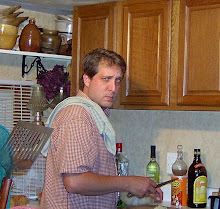
We started growing and selling Holy Basil (Tulsi) about 3 years ago and immediately noticed how difficult and slow they can be. They don't really taste that good, at least to me, which is why I'm guessing they have more medicinal and religious significance in India. So, after a whole lot of practice (and dead plants), here's what I've learned to date. These findings generally apply to all of the varieties, but red (Krishna) can be exceptionally painful.
GROWTH TIME
Start to flowering can take up to 6 months depending on the weather.
HARDINESS
From what I've heard, in their native habitat they're treated as self-seeding semi-hardy annuals.
GERMINATING
For germinating, I use 1201 inserts in standard flats filled 3/4 up with Fafard superfine germinating mix. I can't stress enough the need to use professional sterilized seed starting mix, really, don't make your own. I then spread 30-40 of the seeds in the cell, cover them lightly with a little more soil mix then water them in thoroughly.
All of these, but especially red, can be slow to germinate. Don't be surprised if it takes up to 30 days for them to pop up. The only viable method to help speed that up is to provide bottom heat to bring the soil temp up. It's also quite important for the soil to not dry out or become excessively soggy. For watering during this stage I place the cell in water as opposed to spraying the top of them. If you're in a low humidity environment, like a gas heated house in the winter, a fine mist with a water bottle can help. However, in general I've found that bottom watering ANY plant prevents fungal diseases on the leaves.
GROWING ON
Once the SECOND set of leaves appears they should be transplanted to their final container. To do this, remove the seedlings from the container they were started in and carefully take out 1 plant. Dibble a small hole in the destination container and plant the seedling making sure not to plant it deeper than it originally was and disturbing the roots as little as possible. Once transplanted they can take up to 90 days to be salable, however they could be planted in the ground after 30-45 days.
For wholesale we transplant to Landmark Plastics "sheet of pots". These are 2 1/2" square 3201 type pots that fit in a standard 1020 flat. For local retail and Internet sales we then move these up to 4" round pots.
FEEDING
I have found that Holy Basil is similar to other basil varieties in it's feeding requirements. I use a fertilizer injector with Daniel's 10-4-3 plant food set to 50ppm N at a constant feed. For those of you at home, I would use fish emulsion mixed at 1/2 the instructed rate and start feeding the seedlings weekly when the first true leaves appear. Once transplanted I would increase the strength of the fertilizer (to the labeled rate) and feed 2-3 times a week.
CONCLUSION
Despite the difficult nature, if you follow these general steps you can grow Holy Basil as good as any greenhouse. The largest single requirement for success is patience.

